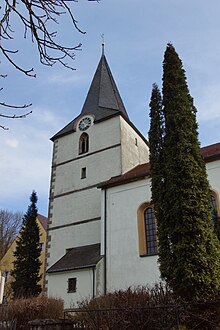Eschenfelden Castle

The Castle Eschenfelden is a abgegangenes Castle in Eschenfelden , now a district of the municipality Hirschbach in Upper Palatinate Amberg-Sulzbach of Bavaria .
history
As early as 1129, the local nobleman Heberhardus de Eschenuelden was named as a witness in a document from the Kastl monastery . In 1132, Bishop Otto of the Bamberg diocese bought Eschenfelden for the Michelfeld Monastery he founded . His successor Egilbert swapped the village for the Gunzendorf estate near Auerbach . During this time the Bambergische Ministeriale was named after Eseult .
Then Eschenfelden fell to the Counts of Hirschberg , who probably received it from the Counts of Sulzbach , who died out in 1188 . From the last Count von Hirschberg, Gebhard VI., The church set and the bailiwick came to the Kastl monastery via Eschenfelden. After the Eschenfelder became extinct, the Ministerialenburg came to the Lords of Breitenstein by inheritance in 1316 . In 1398 Jörg von Breitenstein sold Eschenfelden to Herdegen and Valtzner zu Prague and Bruno as well as Günther and Hans die Liesperger. However, this change of ownership did not last, because afterwards the people of Breitenstein are continuously proven as owners of the Hofmark district court in Sulzbach .
Only Hermann von Breitenstein had to sell the Hofmark to his relative Fuchs von Walburg in 1644 due to over-indebtedness . The Nuremberg patrician family Schlüsselfelder (1652–1660), then the Stettner (1660–1670) and finally in 1712 the Sulzbacher Oberforstmeister Johann Ferdinand Geryll von Altdorf followed as further owners . In 1715 Paul Sigmund von Preysing lived in the castle in Eschenfelden.
In 1733, Count Palatine Johann Christian sold the estate together with the lower jurisdiction and the patronage right to the Harsdorf patrician family from Nuremberg . The estate remained with this family until the middle of the 19th century. The Hofmarks property was finally smashed in 1811, but the sale of the castle property began at the beginning of the 18th century. The castle passed to Friedrich Schwemmer in 1860.
Construction
Nothing is known about the appearance of the castle. It is reported, however, that Eschenfelden “has a beautiful castle where your princely. Graces Count Palatine Augustus zu Sulzbach appointed an administrator ”.
In the 19th century it was demolished by its owner Schwemmer because it was dilapidated and a new building was built in its place. It can be assumed that the church of Eschenfelden used to be the castle chapel of the palace. This is supported by the massive Gothic tower, which can be assigned a defensive and guard function. In addition, in today's choir tower still in the basement loopholes exist that indicate a former castle. The location of a castle near the church is not clearly stated in the Bavarian cadastre , since parcel no. 1, on which the Hofmarkitz is usually to be assumed, is located a bit away from the church.
literature
- Stefan Helml: Castles and palaces in the Amberg-Sulzbach district . Druckhaus Oberpfalz, Amberg 1991, p. 63.
Web links
- Entry on the disappeared Eschenfelden Castle in the private database "All Castles".
- Eschenfelden on the homepage of the Hirschbach community, accessed on July 17, 2020.
- Th. Lauter: News about the von Praittenstein (Braitenstein) . Retrieved July 17, 2020.
Individual evidence
- ^ Max Piendl : Duchy of Sulzbach, District Judge Office Sulzbach . Ed .: Commission for Bavarian State History (= Historical Atlas of Bavaria . Old Bavaria Series I, Issue 10). Munich 1957, p. 60 f ., above ( [1] [accessed July 17, 2020]).
- ↑ See the information in the find aids database in the Amberg State Archives , accessed on July 17, 2020.
- ↑ Th. Lauter, undated, pp. 96f.
Coordinates: 49 ° 34 ′ 43.9 ″ N , 11 ° 37 ′ 1 ″ E


